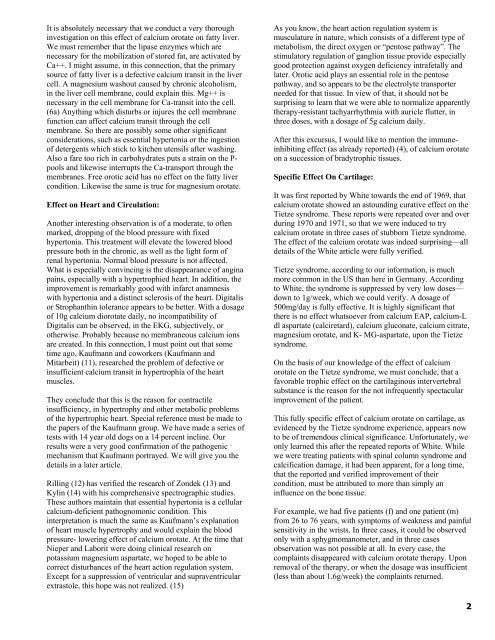Calcium Orotate--Clinical Effects.pdf - Integrative Nutrition Health ...
Calcium Orotate--Clinical Effects.pdf - Integrative Nutrition Health ...
Calcium Orotate--Clinical Effects.pdf - Integrative Nutrition Health ...
Create successful ePaper yourself
Turn your PDF publications into a flip-book with our unique Google optimized e-Paper software.
It is absolutely necessary that we conduct a very thorough<br />
investigation on this effect of calcium orotate on fatty liver.<br />
We must remember that the lipase enzymes which are<br />
necessary for the mobilization of stored fat, are activated by<br />
Ca++. I might assume, in this connection, that the primary<br />
source of fatty liver is a defective calcium transit in the liver<br />
cell. A magnesium washout caused by chronic alcoholism,<br />
in the liver cell membrane, could explain this. Mg++ is<br />
necessary in the cell membrane for Ca-transit into the cell.<br />
(6a) Anything which disturbs or injures the cell membrane<br />
function can affect calcium transit through the cell<br />
membrane. So there are possibly some other significant<br />
considerations, such as essential hypertonia or the ingestion<br />
of detergents which stick to kitchen utensils after washing.<br />
Also a fare too rich in carbohydrates puts a strain on the Ppools<br />
and likewise interrupts the Ca-transport through the<br />
membranes. Free orotic acid has no effect on the fatty liver<br />
condition. Likewise the same is true for magnesium orotate.<br />
Effect on Heart and Circulation:<br />
Another interesting observation is of a moderate, to often<br />
marked, dropping of the blood pressure with fixed<br />
hypertonia. This treatment will elevate the lowered blood<br />
pressure both in the chronic, as well as the light form of<br />
renal hypertonia. Normal blood pressure is not affected.<br />
What is especially convincing is the disappearance of angina<br />
pains, especially with a hypertrophied heart. In addition, the<br />
improvement is remarkably good with infarct anamnesis<br />
with hypertonia and a distinct sclerosis of the heart. Digitalis<br />
or Strophanthin tolerance appears to be better. With a dosage<br />
of 10g calcium diorotate daily, no incompatibility of<br />
Digitalis can be observed, in the EKG, subjectively, or<br />
otherwise. Probably because no membraneous calcium ions<br />
are created. In this connection, I must point out that some<br />
time ago, Kaufmann and coworkers (Kaufmann and<br />
Mitarbeit) (11), researched the problem of defective or<br />
insufficient calcium transit in hypertrophia of the heart<br />
muscles.<br />
They conclude that this is the reason for contractile<br />
insufficiency, in hypertrophy and other metabolic problems<br />
of the hypertrophic heart. Special reference must be made to<br />
the papers of the Kaufmann group. We have made a series of<br />
tests with 14 year old dogs on a 14 percent incline. Our<br />
results were a very good confirmation of the pathogenic<br />
mechanism that Kaufmann portrayed. We will give you the<br />
details in a later article.<br />
Rilling (12) has verified the research of Zondek (13) and<br />
Kylin (14) with his comprehensive spectrographic studies.<br />
These authors maintain that essential hypertonia is a cellular<br />
calcium-deficient pathognomonic condition. This<br />
interpretation is much the same as Kaufmann’s explanation<br />
of heart muscle hypertrophy and would explain the blood<br />
pressure- lowering effect of calcium orotate. At the time that<br />
Nieper and Laborit were doing clinical research on<br />
potassium magnesium aspartate, we hoped to be able to<br />
correct disturbances of the heart action regulation system.<br />
Except for a suppression of ventricular and supraventricular<br />
extrastole, this hope was not realized. (15)<br />
As you know, the heart action regulation system is<br />
musculature in nature, which consists of a different type of<br />
metabolism, the direct oxygen or “pentose pathway”. The<br />
stimulatory regulation of ganglion tissue provide especially<br />
good protection against oxygen deficiency intrafetally and<br />
later. Orotic acid plays an essential role in the pentose<br />
pathway, and so appears to be the electrolyte transporter<br />
needed for that tissue. In view of that, it should not be<br />
surprising to learn that we were able to normalize apparently<br />
therapy-resistant tachyarrhythmia with auricle flutter, in<br />
three doses, with a dosage of 5g calcium daily.<br />
After this excursus, I would like to mention the immuneinhibiting<br />
effect (as already reported) (4), of calcium orotate<br />
on a succession of bradytrophic tissues.<br />
Specific Effect On Cartilage:<br />
It was first reported by White towards the end of 1969, that<br />
calcium orotate showed an astounding curative effect on the<br />
Tietze syndrome. These reports were repeated over and over<br />
during 1970 and 1971, so that we were induced to try<br />
calcium orotate in three cases of stubborn Tietze syndrome.<br />
The effect of the calcium orotate was indeed surprising—all<br />
details of the White article were fully verified.<br />
Tietze syndrome, according to our information, is much<br />
more common in the US than here in Germany. According<br />
to White, the syndrome is suppressed by very low doses—<br />
down to 1g/week, which we could verify. A dosage of<br />
500mg/day is fully effective. It is highly significant that<br />
there is no effect whatsoever from calcium EAP, calcium-L<br />
dl aspartate (calciretard), calcium gluconate, calcium citrate,<br />
magnesium orotate, and K- MG-aspartate, upon the Tietze<br />
syndrome.<br />
On the basis of our knowledge of the effect of calcium<br />
orotate on the Tietze syndrome, we must conclude, that a<br />
favorable trophic effect on the cartilaginous intervertebral<br />
substance is the reason for the not infrequently spectacular<br />
improvement of the patient.<br />
This fully specific effect of calcium orotate on cartilage, as<br />
evidenced by the Tietze syndrome experience, appears now<br />
to be of tremendous clinical significance. Unfortunately, we<br />
only learned this after the repeated reports of White. While<br />
we were treating patients with spinal column syndrome and<br />
calcification damage, it had been apparent, for a long time,<br />
that the reported and verified improvement of their<br />
condition, must be attributed to more than simply an<br />
influence on the bone tissue.<br />
For example, we had five patients (f) and one patient (m)<br />
from 26 to 76 years, with symptoms of weakness and painful<br />
sensitivity in the wrists. In three cases, it could be observed<br />
only with a sphygmomanometer, and in three cases<br />
observation was not possible at all. In every case, the<br />
complaints disappeared with calcium orotate therapy. Upon<br />
removal of the therapy, or when the dosage was insufficient<br />
(less than about 1.6g/week) the complaints returned.<br />
2
















